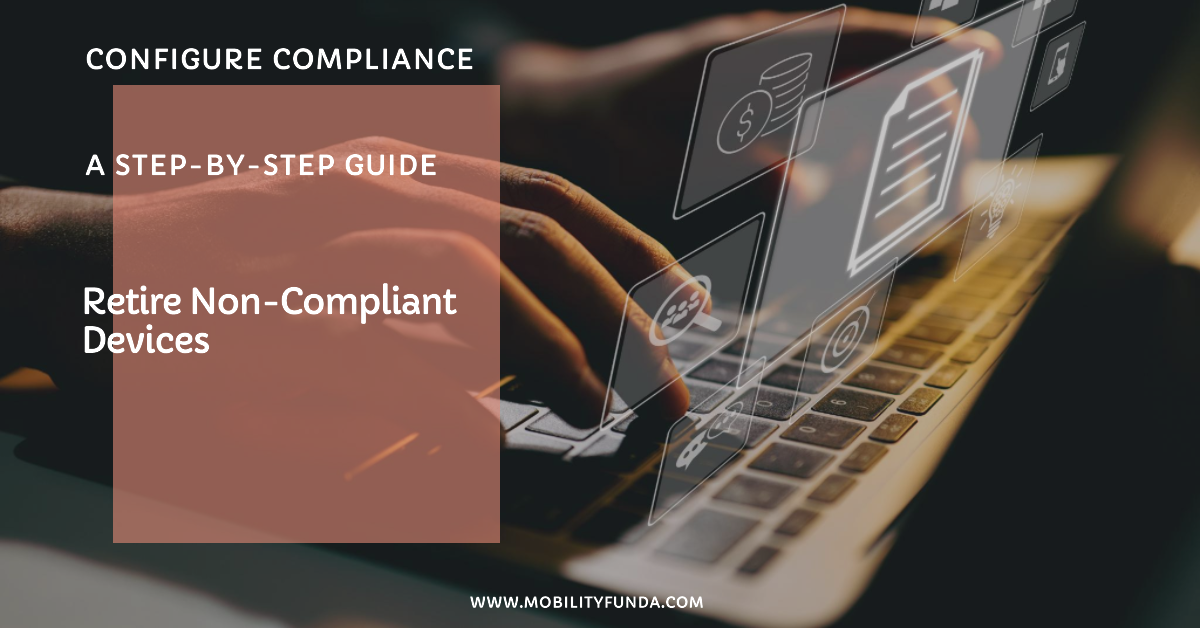Configure Compliance: A Step-by-Step Guide to Retiring Non-Compliant Devices in Intune
Essential for securing an effective IT system, Device Compliance is Ensuring all devices adhere to established security guidelines, organizations safeguard their networks and data today. An all-encompassing answer for regulating and safeguarding apparatus across an association, Microsoft Intune is. Intune helps businesses ensure that sensitive information is secure by implementing device compliance standards.
Compliance depends on defining and enforcing rules related to various security aspects, including operating system versions, encryption settings, and application configurations. Compliance requires adherence to rules set forth in these regulations. By establishing device compliance standards, organizations may minimize the danger of cybersecurity incidents.
Quickly Understand the device compliance policies in Intune
With knowledge of the compliance requirements, Intune must retire non-compliant devices. Compliance is determined by meeting the requirements specified in these standards. Security measures are tailored according to device types, user roles, and geographic locations through configuration. Security parameters, including password complexity, device encryption, operating system version, and application health, fall under device compliance policies. With defined policies, only security-compliant devices are granted permission to access company resources.
Identifying non-compliant devices in Intune
Checking and detecting non-compliant devices must be performed on a regular basis once device compliance guidelines have been put into place. Swift compliance concerns resolution requires this crucial step.
Reports provide an exhaustive assessment of the compliance standing of all supervised devices within Intune. Reports pinpointing non-conforming devices highlight crucial areas needing attention. Immediate detection enables corrective action by analyzing reports of non-compliant devices within an organization.

Configure Compliance: A Step-by-Step Guide to Retiring Non-Compliant Devices in Intune

Configure Compliance: A Step-by-Step Guide to Retiring Non-Compliant Devices in Intune
Step 1: Reviewing devices compliance reports in Intune.
Retirement of non-compliant devices begins with Intune’s device compliance reports. Information contained within these reports assists organizations in detecting potential security threats related to their managed devices.
Within the device compliance area of the Intune console, create a non-compliance report. Throughout this report, you will discover the complete compliance information for each device, alongside any unfollowed policies. Devices with compliance issues require extra scrutiny; focus on those that keep falling short.
Step 2: Analyzing non-compliance issues.
Identifying non-compliant devices is just the first step; analyzing their specific non-compliance issues is crucial next. Identifying the primary reason behind compliance lapses will help shape the subsequent steps of the retirement process, thanks to this examination.
Each non-compliant device requires an examination of the relevant policy guidelines. Some common causes of non-compliance issues include obsolete OSs, neglected updates, and unapproved apps. Effective resolution of these issues hinges on an understanding of them.
Step 3: Communicating to the device owners.
Following the identification of non-compliance issues, establishing direct communication with device owners is key. Ensuring owners grasp the urgency, this step highlights the need to address compliance issues swiftly.
Offering thorough information via direct messaging or email, address any non-compliance concerns you may have with device owners immediately. Non-compliant devices pose substantial risks, underscoring the urgent need for action. Providing links to helpful resources, as well as scheduling updates, constitutes our assistance and guidance.
Step 4: Resolving non-compliance issues.
In order to retire non-compliant devices in Intune, the specific issues discovered during the analysis phase need to be addressed. Taking corrective actions to meet defined security standards is part of this process.
Different actions may need to be taken based on the nature of the non-compliance. Outdated systems call for upgrades when they are used by people. Depending on the existence of unapproved programs, device owners must eradicate them and set up authorized substitutes. Ensure users comprehend the required actions by providing clear directions and support.
Step 5: Retiring non-compliant devices in Intune.
Non-compliance persists in certain situations, and these devices may endanger security. Non-compliant devices should be retired when necessary.
A structured procedure exists for removing non-compliant devices through Intune. Non-compliant devices should be prioritized for identification. Through revoking their Intune management, access to corporate resources will be removed. By completing this step, non-compliant devices will no longer be able connect to the organization’s network or access critical information.
Best practice for retiring non-compliant devices.
Careful planning and execution are required to retire non-compliant devices in Intune. To ensure a smooth and effective process, organizations should consider the following best practices:
- By periodically reviewing and updating policy, compliance with security standards and industry best practices may be maintained.
- Education and clear communication regarding compliance requirements are crucial for device owners.
- Non-compliant device identification and analysis should be handled quickly, resulting in a smooth procedure.
- All compliance-related activities must be thoroughly documented, such as device reviews and addressing non-compliance concerns.
- Devices in Intune must be continuously monitored for compliance; any issues should be addressed immediately.
Effectively retiring non-compliant devices while maintaining a secure and compliant IT environment requires adherence to these best practices.
For more information about Intune you can simply visit and understand more about What is Intune
NOTE: Compliance in Intune is essential for maintaining a secure and efficient IT environment. Compliance challenges can be successfully met by organizations that understand policy and adhere to a structured retirement process. Non-compliant device retirement in Intune is simplified with the best practices detailed here. Organizations that prioritize proactivity in compliance can better mitigate threats and sustain strong security protocols.
